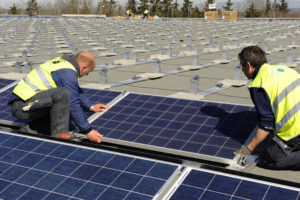 It is important for the solar energy system to be securely fixed to the roof of all installations – and every roof has its own specific requirements. I would like to take the opportunity with this and other blog entries on the subject of “mounting systems” to present the typical mounting options to operators and installers for the most frequent roof types and give them recommendations.
It is important for the solar energy system to be securely fixed to the roof of all installations – and every roof has its own specific requirements. I would like to take the opportunity with this and other blog entries on the subject of “mounting systems” to present the typical mounting options to operators and installers for the most frequent roof types and give them recommendations.
Flat roofs (generally with up to 10 degrees inclination and building heights of up to 25 m) are particularly well-suited to the installation of a PV system – above all when there should be a lot of PV capacity on the roof.
Indispensable: The calculation of load capacity
In the calculation of the load, alongside the components, potentially required ballast, windloads and snow cover in the winter have to be taken into account. There are already several mounting systems with minimal unladen weight and good aerodynamic properties available on the market, which are particularly well-suited to flat roofs.
If the load reserve is very minimal, an east-west orientation of the module array is ideal. Advantage: this means the PV system is less sensitive to the slipstreams and pressure forces of the wind (including thanks to a minimal module inclination of just 10 degrees) and does not have to be as heavily ballasted.
The special features
To protect the seal (foil and bitumen) an additional structural preservation mat is required. Here systems that already have the structural preservation mat integrated in the rail succeed. The pads should be distributed across the rails in such a way that an uninhibited drainage of water is guaranteed.
If the flat roof has insulation, the load capacity of the insulation must be precisely checked in advance. In existing halls it is to be assumed that these are not accessible and for this reason indicate insulation, which has a minimal compressive strength. In newly build houses it is dependent upon whether a PV system was already intended in the planning phase or not. Here, too, problems can arise. In order to be able to better distribute the load of the solar energy system and potential snow, it makes sense to use a system with a broad contact area and broad rails. In the case of intermittent stress, additionally costs for load distribution are to be planned.
Our solution: IBC AeroFix
Systems with continuous profile rails, such as the “IBC AeroFix“, evenly distribute the load across the roof. The IBC SOLAR solution was developed in close cooperation with industry associations and manufacturers of insulation systems. It is suitable for bitumen, foil, green and pebble roofs and offers sufficient stability even without rooftop screw connections. The roof cladding is not damaged and therefore there is no risk of penetration of water. Furthermore, the structural preservation mat is already integrated with gaps for water drainage in the rails, which saves time and therefore costs during installation.
“IBC AeroFix” is particularly light and easy to install and makes fitting much easier with its sophisticated modular construction.
Here you can read about our latest reference system with our customer AVANTAG Energy. They have installed a 1.8 MWp photovoltaic roof mounted system in Rhineland-Palatinate with the tried-and-tested AeroFix system.
Our YouTube channel has a series of short installation videos on the topic. Including:
Flat roof installation fitting solution with east-west orientation
Flat roof installation fitting solution with south orientation
Part 5 of our series is all about “practical installation”. Stay tuned.
This is an awesome article a debt of gratitude is in order for sharing this enlightening data. I will visit your site consistently for some most recent post. I will visit your website consistently for Some most recent post.